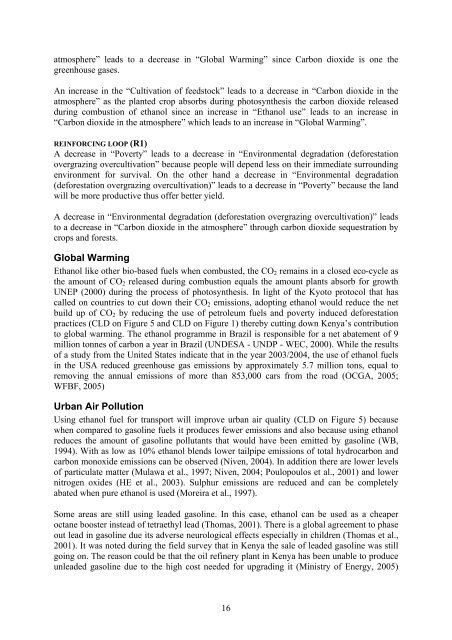ethanol fuel production and use in kenya for sustainable ... - lumes
ethanol fuel production and use in kenya for sustainable ... - lumes
ethanol fuel production and use in kenya for sustainable ... - lumes
You also want an ePaper? Increase the reach of your titles
YUMPU automatically turns print PDFs into web optimized ePapers that Google loves.
atmosphere” leads to a decrease <strong>in</strong> “Global Warm<strong>in</strong>g” s<strong>in</strong>ce Carbon dioxide is one thegreenho<strong>use</strong> gases.An <strong>in</strong>crease <strong>in</strong> the “Cultivation of feedstock” leads to a decrease <strong>in</strong> “Carbon dioxide <strong>in</strong> theatmosphere” as the planted crop absorbs dur<strong>in</strong>g photosynthesis the carbon dioxide releaseddur<strong>in</strong>g combustion of <strong>ethanol</strong> s<strong>in</strong>ce an <strong>in</strong>crease <strong>in</strong> “Ethanol <strong>use</strong>” leads to an <strong>in</strong>crease <strong>in</strong>“Carbon dioxide <strong>in</strong> the atmosphere” which leads to an <strong>in</strong>crease <strong>in</strong> “Global Warm<strong>in</strong>g”.REINFORCING LOOP (R1)A decrease <strong>in</strong> “Poverty” leads to a decrease <strong>in</strong> “Environmental degradation (de<strong>for</strong>estationovergraz<strong>in</strong>g overcultivation” beca<strong>use</strong> people will depend less on their immediate surround<strong>in</strong>genvironment <strong>for</strong> survival. On the other h<strong>and</strong> a decrease <strong>in</strong> “Environmental degradation(de<strong>for</strong>estation overgraz<strong>in</strong>g overcultivation)” leads to a decrease <strong>in</strong> “Poverty” beca<strong>use</strong> the l<strong>and</strong>will be more productive thus offer better yield.A decrease <strong>in</strong> “Environmental degradation (de<strong>for</strong>estation overgraz<strong>in</strong>g overcultivation)” leadsto a decrease <strong>in</strong> “Carbon dioxide <strong>in</strong> the atmosphere” through carbon dioxide sequestration bycrops <strong>and</strong> <strong>for</strong>ests.Global Warm<strong>in</strong>gEthanol like other bio-based <strong>fuel</strong>s when combusted, the CO 2 rema<strong>in</strong>s <strong>in</strong> a closed eco-cycle asthe amount of CO 2 released dur<strong>in</strong>g combustion equals the amount plants absorb <strong>for</strong> growthUNEP (2000) dur<strong>in</strong>g the process of photosynthesis. In light of the Kyoto protocol that hascalled on countries to cut down their CO 2 emissions, adopt<strong>in</strong>g <strong>ethanol</strong> would reduce the netbuild up of CO 2 by reduc<strong>in</strong>g the <strong>use</strong> of petroleum <strong>fuel</strong>s <strong>and</strong> poverty <strong>in</strong>duced de<strong>for</strong>estationpractices (CLD on Figure 5 <strong>and</strong> CLD on Figure 1) thereby cutt<strong>in</strong>g down Kenya’s contributionto global warm<strong>in</strong>g. The <strong>ethanol</strong> programme <strong>in</strong> Brazil is responsible <strong>for</strong> a net abatement of 9million tonnes of carbon a year <strong>in</strong> Brazil (UNDESA - UNDP - WEC, 2000). While the resultsof a study from the United States <strong>in</strong>dicate that <strong>in</strong> the year 2003/2004, the <strong>use</strong> of <strong>ethanol</strong> <strong>fuel</strong>s<strong>in</strong> the USA reduced greenho<strong>use</strong> gas emissions by approximately 5.7 million tons, equal toremov<strong>in</strong>g the annual emissions of more than 853,000 cars from the road (OCGA, 2005;WFBF, 2005)Urban Air PollutionUs<strong>in</strong>g <strong>ethanol</strong> <strong>fuel</strong> <strong>for</strong> transport will improve urban air quality (CLD on Figure 5) beca<strong>use</strong>when compared to gasol<strong>in</strong>e <strong>fuel</strong>s it produces fewer emissions <strong>and</strong> also beca<strong>use</strong> us<strong>in</strong>g <strong>ethanol</strong>reduces the amount of gasol<strong>in</strong>e pollutants that would have been emitted by gasol<strong>in</strong>e (WB,1994). With as low as 10% <strong>ethanol</strong> blends lower tailpipe emissions of total hydrocarbon <strong>and</strong>carbon monoxide emissions can be observed (Niven, 2004). In addition there are lower levelsof particulate matter (Mulawa et al., 1997; Niven, 2004; Poulopoulos et al., 2001) <strong>and</strong> lowernitrogen oxides (HE et al., 2003). Sulphur emissions are reduced <strong>and</strong> can be completelyabated when pure <strong>ethanol</strong> is <strong>use</strong>d (Moreira et al., 1997).Some areas are still us<strong>in</strong>g leaded gasol<strong>in</strong>e. In this case, <strong>ethanol</strong> can be <strong>use</strong>d as a cheaperoctane booster <strong>in</strong>stead of tetraethyl lead (Thomas, 2001). There is a global agreement to phaseout lead <strong>in</strong> gasol<strong>in</strong>e due its adverse neurological effects especially <strong>in</strong> children (Thomas et al.,2001). It was noted dur<strong>in</strong>g the field survey that <strong>in</strong> Kenya the sale of leaded gasol<strong>in</strong>e was stillgo<strong>in</strong>g on. The reason could be that the oil ref<strong>in</strong>ery plant <strong>in</strong> Kenya has been unable to produceunleaded gasol<strong>in</strong>e due to the high cost needed <strong>for</strong> upgrad<strong>in</strong>g it (M<strong>in</strong>istry of Energy, 2005)16
















